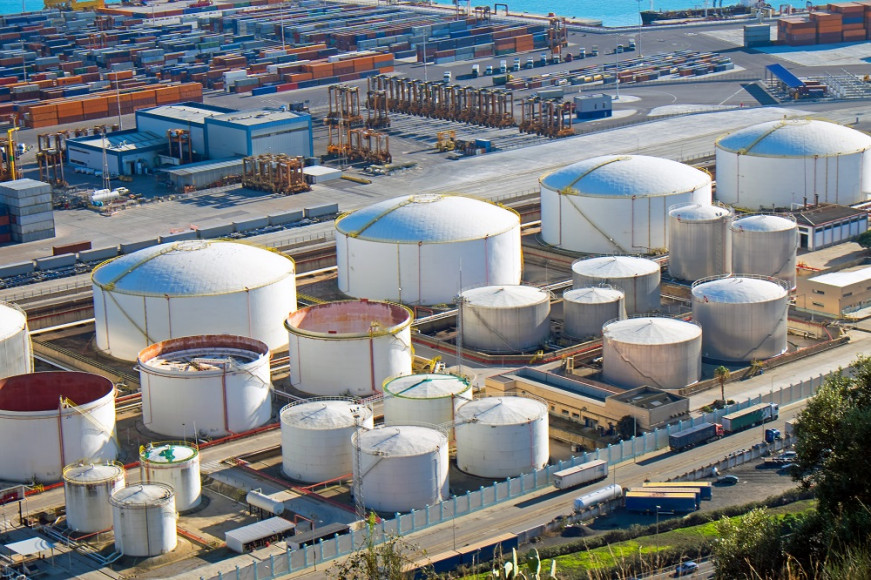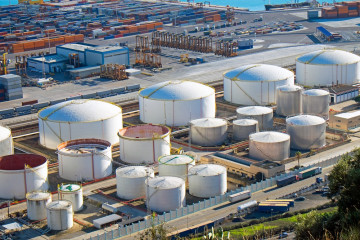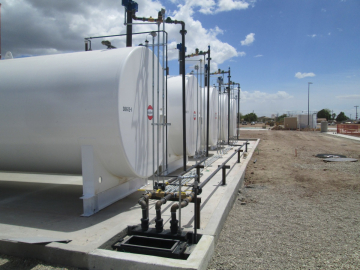Aboveground Storage Tanks (ASTs) are ubiquitous in many industries including transportation, manufacturing, oil and gas, mining, construction, technology, and food and beverage to name a few. If these ASTs contain oil (as defined by 40 CFR 112.2) and the facility meets the threshold and discharge potential criteria, then the ASTs must be managed according to the Federal Oil Pollution Prevention regulation or Spill Prevention, Control and Countermeasure (SPCC) rule.
Two industry standards have been developed to help guide facility owners/operators with tank integrity management. In a recent webinar, our experts compare the two standards – STI SP001 and API 653 – to help owners/operators better understand the applicability of these standards to their own AST assets.
Speakers included Bo Bowman, PE, Senior Engineer with CGRS; Gary Diewald, PE, Spill and Response Plans Service Line Leader with Antea Group; Kipp Sande, PE, Project Manager with Antea Group; and our moderator, Lauren Corbett-Noon, EHS Auditing and Compliance Lead with Antea Group.
If you missed the webinar, you can watch the full session on-demand here:
Watch On-DemandWhy Inspect ASTs?
Before we dive into the different standards and how to apply them, we need to understand why it’s important to inspect ASTs. Most importantly, you must inspect ASTs to comply with federal regulations. The EPA’s oil spill prevention program, which includes the SPCC rule, requires tank owners test or inspect tanks for integrity on a regular basis and/or after repairs. In addition to federal rules, there are also state and local regulations. There are approximately 30 states that currently have regulations with which AST owners and operators must comply.
Beyond regulations, maintaining above ground storage tanks is a best practice. Performing regular inspections will help reduce incidents, lower costs (ex. cleaning up after incidents), and help protect the reputation of your company.
As mentioned above, there are two main standards used to guide tank integrity management.
- STI SP001 - Steel Tank Institute Standard for the Inspection of Aboveground Storage Tanks
- API 653 - American Petroleum Institute Tank Inspection, Repair, Alteration, and Reconstruction
We’re going to dive into each standard to gain a better understanding of when each standard should be applied and how the two standards differ.
STI SP001 Standard
The STI SP001 standard is currently in its 6th edition, released January 2018. The standard provides inspection and evaluation criteria to determine the suitability for continued service, until the next scheduled inspection. It is applicable to ASTs storing stable, flammable, and combustible liquids at atmospheric to 1 pound per square inch gauge (PSIG) pressure but can also be applied to tanks storing other liquids following proper evaluation.
The standard applies to the following:
- Shop-built/fabricated ASTs - horizontal or vertical, single- or double-walled
- Steel diked ASTs - open or closed
- Concrete exterior ASTs
- Field-erected ASTs - limited size
- Portable containers – drums, totes (Intermediate bulk containers)
Shop-Fabricated ASTs
A shop-fabricated AST could be welded carbon or stainless steel that has been manufactured in a shop and transported to the site. If you are unsure if you have a shop-fabricated AST, there are certain criteria you can look for including the manufacture tank plate, standard certification plate, capacity and lifting lugs, or the tank specifications and purchasing records.
STI Inspection Components
|
Tank thickness determination |
Insulation covering |
|
Secondary tank condition |
Normal vents |
|
Tank supports |
Emergency vents |
|
Tank anchors |
Release prevention barriers |
|
Overfill valves and alarms |
Spill control systems |
|
Tank foundation and external supports |
Tank valves and connections (piping) |
|
Tank gauges and alarms |
|
Tank Inspection Frequency
To understand the frequency and type of inspections required for your tank, you need to examine several factors including the inspection types, the risk category of the AST, and a few key definitions. There are four STI SP001 inspection types.
P: Periodic AST Inspection – this inspection is performed on a monthly and annual basis by the tank owner or operator knowledgeable in tank operations (this can also be contracted out).
E: Formal External Inspection (FEI) – this inspection must be conducted by a certified STI inspector.
I: Formal Internal Inspection (FII) - this inspection must be conducted by a certified STI inspector.
L: Leak tests performed by the tank owner or the owner’s designee.
Using the chart from STI SP001 Table A2.2 below, you can identify what kind of tank configuration you have and use that to determine the AST risk category. CDRM stands for Continuous Release Detection Method, which is a means of detecting a release of liquid through inherent design. CRDM is passive; liquid releases are visually detected by facility operators. Spill control refers to tanks configured with secondary containment features. These features include dikes, double-walled tanks, or remote impoundment.
From here you can identify the type and frequency of the inspections required for your tank based on the matrix provided by STI SP001 Table 5.5. Example: P, E (20) means that you must perform Periodic AST Inspections and every 20 years a Formal External Inspection (FEI).
API 653
The API 653 standard is an intensive inspection method for large field-erected tanks covering both internal and external inspections. This standard is currently in its 5th edition, released November 2014. API 653 offers minimum requirements for maintaining integrity after the tank has been placed in service. The standard is intended to address inspection, repair, relocation, and reconstruction of ASTs by assessing the sustainability for continued use, identifying brittle fracture risk, and recognizing fitness-for-service assessment concepts for evaluating in-service degradation of pressure containing components.
Field-Erected ASTs
API 653 is designed for field-erected ASTs of any capacity (although typically greater than 75,000 gallons), any size, that are either welded or riveted. If you’re unsure if you have a field-erected tank, there are certain criteria you can look for, including the manufacturer tank plate, standard certification plate, capacity, lack of lifting lugs, rough weld patterns, rounded stairway, tank support, and/or tank specifications and purchasing records.
AST Inspection Components
|
Tank foundation |
Survey – Settlement/Roundness |
|
Shell – flaw and thickness detection |
Brittle fracture/failure assessment |
|
Structure – welds |
Roof |
|
Bottom – flaw and thickness detection |
Cathodic/Coatings |
|
Attached appurtenances |
Design loads: wind, snow, seismic |
|
Nozzles to face of first flange, first threaded joint, or first welding-end connection |
|
Inspection Frequency
The API 653 standard requires that three types of inspections be done on a regular basis: routine inspections, external inspections, and internal inspections. Routine in-service inspections should be performed monthly by the owner or operator of the tank and includes looking for external indicators that something is wrong. General knowledge of tank operations is required.
External inspections must be performed every five years by an authorized API 653 inspector.
Finally, internal inspections require that you open the tank, clean it out, and inspect from inside. This is the most expensive of the three inspections and also requires an authorized API 653 inspector.
STI SP001 or API 653 – Which Standard is Right for You?
Both standards will help you comply with SPCC requirements, but which one is right for your operations? To put it simply – if you have shop-built tanks or smaller field-erected tanks, then STI SP001 is a good fit for your tank inspections and maintenance. For all larger field-erected tanks and/or tanks that are riveted, go with the API 653 inspection standard.
At the end of the day, there are several best practices you should implement to ensure you are properly maintaining the integrity of your tanks. Gather data on your tanks and develop a good knowledge of your tanks and their components. Compile your existing records from inspections you are already performing and use these records to identify any gaps. You should keep inspection records for at least three years; however, we recommend keeping them for the life of the tank. From there, you can develop and implement protocols for tank inspection and maintenance such as training employees, hiring contractors, and allocating budget to ensure you are conducting proper tank inspections and maintenance.
Contact our experts for more information on these two standards and to help maintain your AST tank integrity.
Want more news and insights like this?
Sign up for our monthly e-newsletter, The New Leaf. Our goal is to keep you updated, educated and even a bit entertained as it relates to all things EHS and sustainability.
Get e-NewsletterHave any questions?
Contact us to discuss your environment, health, safety, and sustainability needs today.






